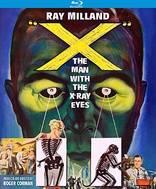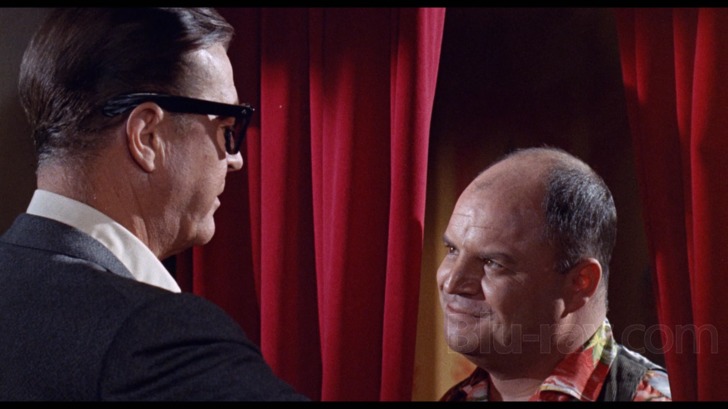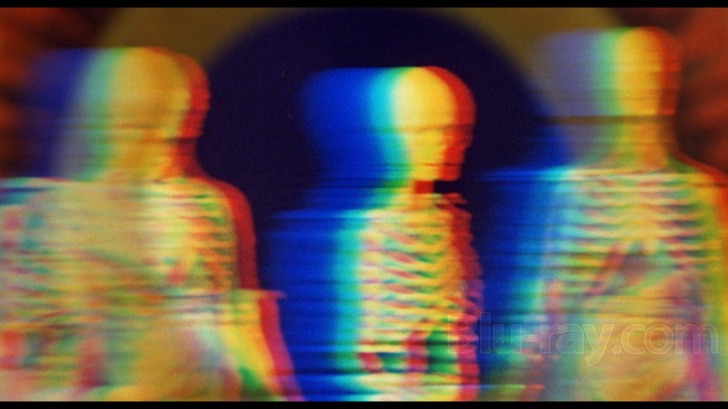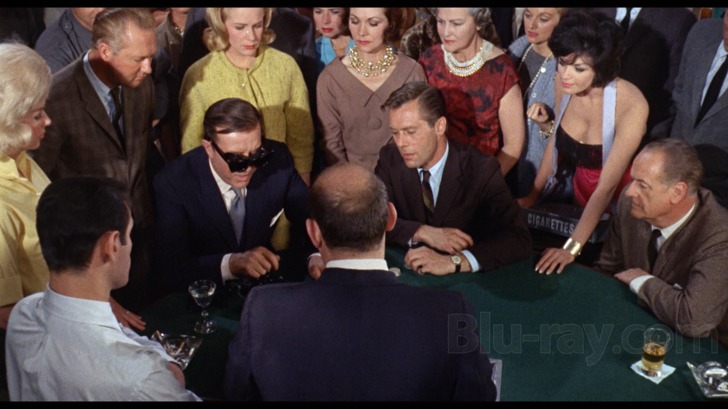X: The Man with the X-Ray Eyes Blu-ray Movie
HomeX: The Man with the X-Ray Eyes Blu-ray Movie 
Kino Lorber | 1963 | 79 min | Not rated | May 12, 2015
Movie rating
7 | / 10 |
Blu-ray rating
| Users | 0.0 | |
| Reviewer | 4.0 | |
| Overall | 4.0 |
Overview
X: The Man with the X-Ray Eyes (1963)
A doctor uses special eye drops to give himself x-ray vision, but the new power has disastrous consequences.
Starring: Ray Milland, Diana Van der Vlis, Harold J. Stone, John Hoyt (I), Don RicklesDirector: Roger Corman
| Horror | Uncertain |
| Thriller | Uncertain |
| Sci-Fi | Uncertain |
Specifications
Video
Video codec: MPEG-4 AVC
Video resolution: 1080p
Aspect ratio: 1.85:1
Original aspect ratio: 1.85:1
Audio
English: DTS-HD Master Audio 2.0 Mono (48kHz, 16-bit)
Subtitles
English
Discs
25GB Blu-ray Disc
Single disc (1 BD)
Playback
Region A (B, C untested)
Review
Rating summary
| Movie | 4.0 | |
| Video | 4.0 | |
| Audio | 4.0 | |
| Extras | 4.0 | |
| Overall | 4.0 |
X: The Man with the X-Ray Eyes Blu-ray Movie Review
Seeing Too Much
Reviewed by Michael Reuben May 13, 2015One of the films for which prolific producer/director Roger Corman will be best remembered was originally titled just X, but it is now known by the subtitle that distributor American International Pictures used to promote it: The Man with the X-Ray Eyes. AIP had the right idea. Without the subtitle, no one would have known that Corman's taut, low-budget quickie was a sci-fi thriller aimed at the exploitation market. What even the marketing gurus at AIP couldn't anticipate, however, was the lasting impression that X would leave on many audience members, a phenomenon reflected in the new extras on this Blu-ray, or the film's durability. Credit the metaphoric potence of the film's central device: a scientist whose desire to see everything ultimately drives him mad. Like many great stories, X can be interpreted many ways, and it continues to resonate with audiences, even as science and filmmaking techniques have advanced far beyond what existed in 1963 when Corman made the film for $300,000.

Dr. James Xavier (Ray Milland, an Oscar winner for The Lost Weekend , who previously worked with Corman on The Premature Burial) is a successful surgeon who has stopped practicing medicine to devote himself to pure research. He has developed a serum that enhances the eye's ability to see light waves beyond the 10% of the spectrum it normally perceives. The compound works on monkeys, but Dr. Xavier is impatient for a human trial. In the time-honored tradition of overconfident scientists, he tests his drug on himself, despite the misgivings of his own physician, Dr. Sam Brant (Harold J. Stone), and the representative of the foundation supporting his research, Dr. Diane Fairfax (Diana Van der Vlis). The serum works, but the foundation's board cuts off Xavier's funding anyway, convinced that his research is of questionable value. Xavier attempts to return to medicine, but he is already hooked on his quest. Besides, he can already point to the benefits of his enhanced vision in his superior diagnostic abilities. Impatience and frustration get the better of him, and soon Xavier is an outcast and a fugitive, forced to conceal his identity while he makes a meager living as a "mentalist" in a carnival sideshow. His barker, Crane (Don Rickles), recognizes a good thing when he sees it and persuades Xavier to set up shop as a kind of faith healer. It is here that Diane Fairfax tracks him down, motivated in equal parts by scientific curiosity, guilt over her inability to persuade the foundation to continue funding Xavier's experiments, and a budding love for the man obsessed with seeing more than anyone has ever seen before. By this point, Xavier wants nothing more than to disappear somewhere quiet with enough money to continue his research, so that he can better control his ever-expanding vision. Even with thick, lead-lined glasses, he no longer sees the world as we do. As Diane drives him out of town, he describes how he sees the city: "Rising into the sky with fingers of metal, limbs without flesh, girders without stone. Signs hanging without support. Wires dipping and swaying without poles. A city unborn. Flesh dissolved in an acid of light." Xavier joins a long line of fictional scientists, reaching back to Victor Frankenstein, whose hubris leads them to tamper with forces of nature they cannot control. But X's script by Ray Russell (Mr. Sardonicus) and Robert Dillon (French Connection II) adds further layers that Corman allows to develop quietly below the surface. After escaping Crane's clutches, Xavier flees with Diane to Las Vegas, where his enhanced vision allows him to win game after game at the blackjack tables. But instead of quietly cashing in his winnings, the now unhinged scientist cannot resist bragging about his abilities, thereby attracting close scrutiny by an already suspicious casino management. As he attempts to escape, Xavier stumbles upon a revivalist preacher and his flock, where the story reaches a conclusion that can be interpreted various ways (and that's without even considering the additional, and possibly apocryphal, dialogue first reported by Stephen King in his book Danse Macabre). At its most literal level, the conclusion involves a debate between Xavier and the preacher over whether the doctor has seen the face of God or the devil; either one is too terrible a sight to behold. The scene also recalls a classic moment in Greek tragedy—a point Corman notes in his commentary—that the playwright Sophocles accompanied with the famous words: "Alas, how terrible is wisdom when it brings no comfort to the man that's wise!" (Fans of Angel Heart will recognize this as a line quoted by Robert De Niro's character.) Having achieved his desire to see everything, Dr. Xavier finds neither comfort nor satisfaction in the achievement—indeed, the opposite. Sensory overload and its effects were just becoming a topic of interest when Corman made X, and he would return to it four years later with the explicitly LSD-themed The Trip . Still, the topic remains just as relevant today, when our senses are more likely to be bombarded electronically than with hallucinogens. Corman's techniques for suggesting how Xavier's mutated eyes see the world are primitive by contemporary standards, but they are also refreshing in their naiveté. Today's digital artists would produce something too much like the tableaux we've already seen in big-budget movies. However inexpensive his methods, Corman was doing something new, and it still feels like it.
X: The Man with the X-Ray Eyes Blu-ray Movie, Video Quality 

Much of X was shot by Floyd Crosby, Corman's usual cinematographer, but portions were shot by an unidentified replacement after Crosby became ill during the three-week shoot. (The replacement may have been Corman himself.) According to Corman's commentary, instead of using industry-standard Kodak film, Corman photographed X on Pathé stock to save money. Corman may be misremembering, and it's possible that he simply used the cheaper Pathé lab to process standard Kodak stock. Either way, the credits state that the film is in "Pathécolor". Skimping on film quality was just one of many corners that Corman typically cut to control his budget. Kino's 1080p, AVC-encoded Blu-ray has been taken from a good, though not perfect, source. Occasional small scratches and other imperfections can be seen, but they pass by quickly and are rarely a distraction. The image has remarkable definition and detail for a low-budget feature from this era, especially given the film stock, which yields a resolution and texture that is at least as good as a first-rate 16mm production and often better. The grain pattern is visible but not distracting, and it does not appear to have been subjected to inappropriate electronic manipulation. The colors are very good, establishing a strong contrast between the more naturalistic palette of the real world and the intense and oversaturated hues of Dr. Xavier's altered vision. Even the carnival milieu, where one would expect garish decor, looks muted compared to how Xavier sees the world. Kino has mastered the film with an average bitrate of 25.69 Mbps, which is the least one would expect with such accurate grain reproduction. Artifacts were not an issue.
X: The Man with the X-Ray Eyes Blu-ray Movie, Audio Quality 

The film's original mono track has been encoded as lossless DTS-HD MA 2.0, with identical left and right channels. Lossless encoding cannot compensate for the limitations of the source, which has limited dynamic range and very little low end. Nevertheless, the dialogue is clear; there is no distortion or background noise; and the eerie, old-time radio thriller score by the prolific Les Baxter, another Corman regular (House of Usher, Tales of Terror), has never sounded better.
X: The Man with the X-Ray Eyes Blu-ray Movie, Special Features and Extras 

MGM released X on DVD in 2001 with a commentary by Roger Corman and the original prologue and trailer included here. Kino's release features several new extras.
- Commentary with Director Roger Corman: Corman is a genial speaker, and he provides an entertaining overview of both the development of X and its production. Still, it's a good idea to fact-check the details, because the producer/director has told alternate versions of key events at different times. Notably, he has both confirmed and denied Stephen King's account of additional dialogue in the film's final scene—dialogue that does not appear in the shooting script and that Corman would have had to invent on the set and for which no deleted footage has ever been found.
- Commentary with Film Historian Tim Lucas: Densely packed with information and allusions to other works of cinema, Lucas' commentary is an exhaustive guide to X, its production and its place in Corman's work and cinema history. Among the many valuable insights, Lucas describes portions of the shooting script that were omitted (and why). He also provides background on many of the supporting actors, notes themes that recur throughout Corman's films and draws parallels to a diverse array of other filmmakers.
- Buried Alive! Joe Dante on "X" (1080p; 1.78:1; 6:07): A noted graduate of the Corman "school", Dante discusses the film and its themes.
- Rare Prologue (1080p; 1.85:1; 4:59): According to IMDb, this prologue about the human senses appeared in the film's release prints but was subsequently removed.
- Trailers from Hell with Mick Garris (1080p; 1.78:1; 2:34): This installment from the web series features director Mick Garris commenting on the trailer for X.
- Original Theatrical Trailer (1080p; 1.85:1; 2:19): "Filmed in the new photographic process Spectarama!" Which came as news to the film's director, who says in his commentary that he never heard the term until he saw the marketing campaign.
X: The Man with the X-Ray Eyes Blu-ray Movie, Overall Score and Recommendation 

One of the many films that X anticipates is David Cronenberg's Scanners, in which a "derangement of the synapses" transforms some peoples' brains into a sensory organ that receives thoughts from the brain of every person near them. The din of these voices is more than the "scanners" can bear, and most go mad. Scanners takes the phenomenon in a different direction, but the starting point is remarkably similar to Dr. Xavier's predicament of sensory overload as his vision expands. Maybe someone is already working on a contemporary variation in which the brain is enhanced with a device for receiving a stream of unlimited digital information in real time in an effort to meld human and artificial intelligence—what would happen to one's sense of "self"? The brilliance of X is how effectively it captures both the allure and the danger of too much knowledge, a temptation that goes back to the Garden of Eden. Kino's presentation is a good one. Highly recommended.
Similar titles
Similar titles you might also like

Maniac
Forbidden Fruit: The Golden Age of the Exploitation Picture Vol. 17
1934

The Bride of Frankenstein 4K
1935

The Invisible Man 4K
1933

Hammerhead
Sharkman
2005

The Manster
The Split
1959

The Phantom Creeps
1939

The Curse of Frankenstein 4K
Warner Archive Collection
1957

The Invasion 4K
Limited Edition
2007

The Invisible Ray
1936

Demonoid: Messenger of Death
Macabra / La mano del diablo / Les doigts du diable
1981

Possessor 4K
Uncut
2019

Scanners
1981

Spiders
2000

The Lazarus Effect
2015

Firestarter
1984

Splice
2009

Splinter
2008

Nazis at the Center of the Earth
2012

The Quatermass Xperiment
Special Edition | The Creeping Unknown
1955

Invasion of the Body Snatchers 4K
1956